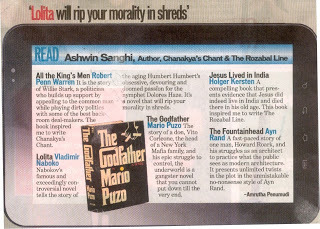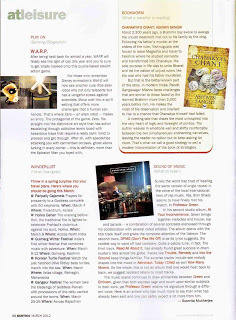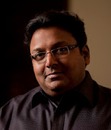Ashwin Sanghi's Blog, page 2
June 15, 2012
DNA: Going By The Book, Aug 7, 2012
 Says Siddharth Roy Kapoor, MD – Studios, Disney, UTV, which is making Bhagat’s Three Mistakes, Revolutions 2020 and Ashwin Sanghi’s Chanakya’s Chant, “Indian English writers are writing stories that are rooted and accessible. Ten-fifteen years ago, the writing was elitist and not pan-India but since the past five-seven years, it has become mass-oriented. Since films are a mass medium, these books easily lend themselves for adaptations.”
Says Siddharth Roy Kapoor, MD – Studios, Disney, UTV, which is making Bhagat’s Three Mistakes, Revolutions 2020 and Ashwin Sanghi’s Chanakya’s Chant, “Indian English writers are writing stories that are rooted and accessible. Ten-fifteen years ago, the writing was elitist and not pan-India but since the past five-seven years, it has become mass-oriented. Since films are a mass medium, these books easily lend themselves for adaptations.”
Published on June 15, 2012 06:44
Myth Merchants, Calcutta Times, Aug 11, 2012
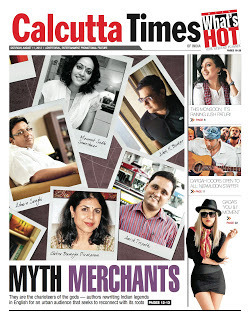
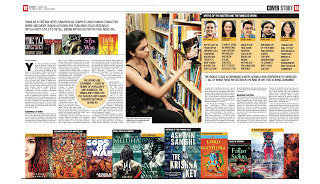
SHIVA AS A TIBETAN HERO, DRAUPADI AS COMPLEX AND HUMAN CHARACTER. MORE AND MORE INDIAN AUTHORS ARE PUNCHING SOLID RESEARCH WITH A RACY STYLE TO RETELL INDIAN MYTHS AS POP FICTION. READ ON...By Dibyajyoti Chaudhuri, Calcutta Times You could call them the charioteers of the gods. Armed with solid research, a vivid imagination and a gripping writing style, a host of authors is dipping into the vast pool of Indian mythology to come up with powerful tales — and takes — that retell our social and historical origins. So you have Amish Tripathi showing Shiva as a Tibetan hero who migrates and attains divinity in a distant land. Ashok K Banker reinvents Sita, Ravan and Ram in his Ramayana series, while Devdutt Pattanaik deconstructs some of our myths and legends in his Myth=Mithya. Ashwin Sanghi, Manreet Sodhi Someshwar, Chitra Banerjee Divakaruni... the list of authors reworking age-old stories is growing longer. The results are often stunning — both in terms of popularity and business. The tomes are flying off the shelves, with many readers in the 18-40 age group. Amish, whose Shiva series has been a runaway hit, says his books have generated retail sales worth 17 crore. Ashok, who has seen the market for such books grow over the years, says his books have sold 1.4 million copies till now. So what is it that’s drawing the XBox generation? “There are some crucial reasons for this. You see, in Greece or Egypt, no one talks about Zeus or Amun Ra. But Indian mythology surrounding Ram, Krishna or Shiva is very much alive in the Indian mind. They have become a part of our collective consciousness,” says Amish, who also sees economic factors at play. “In the last 20 years, we’ve emerged as an economically confident nation and there’s a newfound interest in our culture. I’d say we’re at the right place at the right time.” Author Ashwin Sanghi feels a change in demography has a lot to do with the popularity of mythology. “Tales of Ramayana and Mahabharata were traditionally conveyed by elders in the family to youngsters. Breaking up of the family structure and the Indian diaspora spreading far and wide has created a need for the new generations to connect with their culture. A modern format of retelling the stories is important for this generation. The retelling has led to the blurring of lines between mythology and history,” he says. Bookstore owners feel that the racy, new-age storytelling style of these authors helps. “We all knew these characters, but they have been retold and mythical figures have been humanized. These novels are popular across the board,” says Gautam Jatia, CEO of Starmark. The designs, too, are in sync with the smart writing. Rashmi Pusalkar, who’s designed Amish’s covers, says, “Shiva is a human of flesh and blood, he is not a god. The challenge was to show him as vulnerable. I portrayed him from the back, because Indian gods are never seen from the back. He has battle scars and a sculpted physique.” Gunjan Ahlawat, the designer for Ashwin Sanghi’s upcoming The Krishna Key, talks about using fonts and typography that connects with the youth. Says Jadavpur University student Sabyasachi Chaudhuri. “You feel good the moment you hold these books. Flashy covers, smart prints — you feel like grabbing a copy,” he says. The genesis of the trend goes back to the ’90s, when Ashok K Banker came up with his Ramayana series. “Back then, some saw it as pro-Hindutva writing. However, there was a huge pool of great stories, never published before for new-age readers. Modern storytelling had become obsessed with the self; this new genre was a break from that. Now, other writers have found success in this genre,” he says. Author Manreet Sodhi Someshwar, whose Taj Conspiracy has been a big hit, is still a bit cynical. “The immense success of some recent books — the Meluha trilogy for instance — might give the impression that re-inventing Indian history/mythology has been a huge success, but it could also be a fad. I guess we’ll have to wait and see how the genre grows. However, one big change is that earlier what sold in India was primarily literary fiction which had been endorsed by the West. But, of late, Indian fiction has burgeoned and we now have a wide range of writings by Indian authors. Hitherto unexplored genres have also opened up,” she says. Can we call this retelling of our legends pulp mythology? Chitra Banerjee Divakaruni reacts sharply to the term. “I would definitely not call this pulp mythology, a term which implies a lack of seriousness and commercialization. My Palace of Illusions — which shows Draupadi as a complex, human character — as well as other books on Indian mythology are based on careful, thoughtful and sometimes risky reconstructions. They follow in the footsteps of centuries old re-imaginings such as the Kambha Ramayana, the Ramcharitamanasa and the versions of Krittibas and Kashidas,” Chitra says. Manreet agrees with Amish and feels that as the Indian economy is growing, the middle class is expanding and we are seeing a new confidence in ourselves — all of which finds reflection in the kind of art that is being consumed now. “New writers don’t feel the compulsion to write for a Western market because the domestic market is sufficiently robust and is showing a demand for local stories, set within Indian locales and Indian history,” she says. Siddharth Pansari, franchise owner of Crossword bookstore, feels if there were just a handful of Indian authors before, there are now thousands. “Da Vinci Code was a huge hit, although it was set in the backdrop of the Vatican. It is natural that such a book set in an Indian backdrop will do well. Which is why stories dealing with our indigenous myths have so many takers,” he says. Schoolteacher Paromita Dutta couldn’t agree more. “Many of us have not read the Ramayana or Mahabharata in the original form. These re-telling of ancient stories are simply great,” Paromita says. But is a country that is sensitive about its religious and cultural sentiment a good place to experiment with the gods? “What is true mythology? The creation myths in Shiva Purana and Brahma Purana are different. Which one do we believe? The Kambha Ramayana and Ramacharitamanasa are different from the Valmiki Ramayana. There is a lovely line in the Rig Veda which perhaps sums it up nicely. ‘Ekam sat, viprah bahuda vadanti’. Truth is one, wise men speak it differently,” says Amish. Amen to that.
Published on June 15, 2012 06:29
June 14, 2012
English mass-market books tap Hindi speakers (Chanakya's Chant launched in Hindi), IANS, Aug 10, 2012
English mass-market books tap Hindi speakers New Delhi: Popular books in English are cutting through the language barrier to reach Hindi speaking readers in north India. Five commercially successful titles, ‘Hello Bastar’, ‘The Secret of the Nagas’, ‘Chanakya`s Chant’, ‘Women & The Weight Loss Tamasha’ and ‘Two Fates: The Story of My Divorce’, have been translated into Hindi under a new-tie-up between Westland Limited and Yatra Books to promote translation of books and original titles in Indian languages. "The idea was to realise the true potential of the Hindi market because Hindi is the fourth major language in the world - after Mandarin, English and Spanish. But the publishing industry does not reflect this," writer Namita Gokhale, co-owner of Yatra Books, told IANS. There is a new creative confluence of Indian writing unfolding before us, enabled by "insightful translations and cross-literary exchanges with 22 scheduled languages as well as Indian translations of international works", Gokhale said. The last decade has seen an increase in the volume of translated literature and orignal titles in Hindi with major publishing houses like Penguin and Harper Collins-India collaborating with language publishing companies and even publishing Hindi titles in their main imprint. The efforts have been complemented by institutional initiatives by the government`s translation projects and those launched by foreign missions in India. Hindi is the language of preference in translations given the large readership. A translation project, ‘Indian Literature Abroad’ launched by the culture ministry, is promoting indigenous literature in Indian languages abroad. But mass market fiction has been neglected by translators in the zeal to promote classics and textbooks from English to Hindi. Last year, writer Namita Gokhale`s novel ‘Paro: Dreams of Passion’ was translated into Hindi by Rachna Bhola Yamini while writer Chetan Bhagat`s popular books like ‘One Night @ The Call Centre’ and ‘The 3 Mistakes of My Life’ have climbed the best-sellers` list in Hindi. Salman Rushdie`s best-selling historical mass-fiction, ‘Enchantress of Florence’ was translated as ‘Florence ki Jadugarni’ in 2009. "It is a good idea to bring what is popular in Hindi because it feels nice to address the wide readership. I don`t think this is a trend but it definitely is a way to get acquainted with India. Hindi is the most hospitable language," writer-poet Ashok Vajpeyi told IANS. Best-selling author Ashwin Sanghi says "only the surface has been scratched and the possibilities are immense". "There are so many people who try to think like us but would rather express it better in languages like Hindi. Translations of popular fiction such as ours which have been drawn from Indian traditions help them identify with our thoughts and relate better," Sanghi told IANS. His book Chanakya`s Chant is a contemporary interpretation of the life of the Brahmin philosopher and strategist Chanakya in the context of Indian politics. Mumbai-based Amish, author of the ‘Immortals of Meluha’ and ‘The Secret of the Nagas’, says publishing is finally becoming rooted in Indian sensibilities. "I genuinely believe those five years from today, we will have a situation when other languages will account for higher sales of books than in English. That is the big change happening in publishing - it is taking pride in its own culture than knowing other cultures like in television, where regional language channels have more TRPs," Amish told IANS. Writers benefit as well in terms of bounty from increased sale, he said. "As a writer, I have a vast network of friends who wanted to know when `Hello Bastar` will be published in Hindi. There is a section which is comfortable in English but would rather like to read in Hindi," writer-journalist Rahul Pandita, the author of ‘Hello Bastar’, told IANS. He said platforms like Flipkart have "made it possible for Hindi speaking readers to access translations". "No publisher in the right mind can ignore the Hindi readership for there is a huge market for mass market books, including translations. Hindi speaking readers are Net savvy and are reading new books," Pandita said. IANS
Published on June 14, 2012 06:55
The Hindu: History Meets Thrill, Aug 7, 2012
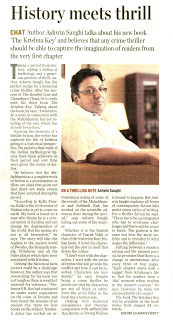 Author Ashwin Sanghi talks about his new book ‘The Krishna Key’ and believes that any crime thriller should be able to capture the imagination of readers from the very first chapter Taking a period from history, adding a dollop of mythology and a generous portion of thrill, author Ashwin Sanghi has the perfect recipe for a historical crime thriller. After the success of The Rosabel Line and Chanakya’s Chant, he is ready with his third book The Krishna Key. Talking about the book, he says, “I wanted to do a story in connection with the Mahabharata, but not retelling of the epic which has already been done.” Keeping the elements of a thriller fiction, the writer has explored the life of Krishna giving it a historical perspective. He explains that most of the Indian mythological figures have been achievers in their period and over time were given the status of deities. He believes that the Mahabharata as a complete work of fiction is a presumption as there are clues that point out that there are some events that have occurred during the period. “According to Kalki Purana, Kalki is the 10 th avatar of Vishnu who is yet to come on earth. My book is based on a man who thinks he is a reincarnation of Krishna and can change the degeneration of the world. But his means are not at all benevolent,” he says. The story will take the readers to the ancient world of Dwarka, the Somnath temple, Vrindavan and all the other places which have been associated with Krishna. Getting the historical facts correct could be a challenge; however, the author says that researching for his book was not tough as there is wealth of material for reference. “Professor S.R. Rao had conducted an under water exploration on the coast of Dwarka and have found the remains of an ancient city, there are four books on the subject. Narahari Achar has worked on astronomical dating of some of the events of the Mahabharata and Subhash Kak has worked on the scientific advances done during the period,” says Ashwin Sanghi listing out some of his sources. Whether it is the brutish character of Taarak Vakil or that of the historian Ravi Mohan Saini, it is not the characters but the plot in itself that drives the author. “I don’t start with the characters. I start with the series of events that will provide the conflict and how it can be resolved. Characters are incidental,” he says. Despite being a crime thriller he points out that his characters are not all black or white. Even the serial killer in the book has a human side. Dealing with historical conspiracies and theories, comparison with authors like Dan Brown or Irwing Wallace is bound to happen. But Ashwin Sanghi explains all forms of contemporary fiction falls under seven styles of writing. For a thriller fiction he says, “There has to be a protagonist who has to overcome challenges and there will be a race to finish. The pattern is the same but how the story unfolds and is revealed is what makes the difference.” Flitting between a modern setting and the ancient period, he promises that there is a change in momentum after every three or four pages. “Each chapter starts with a nugget from Krishnna’s life so that the readers have a ‘aha’ moment when reading in the modern context,” he says. However, he rules out any possibility of a sequel. The book The Krishna Key will be available in the book stores from August 24 onwards.
Author Ashwin Sanghi talks about his new book ‘The Krishna Key’ and believes that any crime thriller should be able to capture the imagination of readers from the very first chapter Taking a period from history, adding a dollop of mythology and a generous portion of thrill, author Ashwin Sanghi has the perfect recipe for a historical crime thriller. After the success of The Rosabel Line and Chanakya’s Chant, he is ready with his third book The Krishna Key. Talking about the book, he says, “I wanted to do a story in connection with the Mahabharata, but not retelling of the epic which has already been done.” Keeping the elements of a thriller fiction, the writer has explored the life of Krishna giving it a historical perspective. He explains that most of the Indian mythological figures have been achievers in their period and over time were given the status of deities. He believes that the Mahabharata as a complete work of fiction is a presumption as there are clues that point out that there are some events that have occurred during the period. “According to Kalki Purana, Kalki is the 10 th avatar of Vishnu who is yet to come on earth. My book is based on a man who thinks he is a reincarnation of Krishna and can change the degeneration of the world. But his means are not at all benevolent,” he says. The story will take the readers to the ancient world of Dwarka, the Somnath temple, Vrindavan and all the other places which have been associated with Krishna. Getting the historical facts correct could be a challenge; however, the author says that researching for his book was not tough as there is wealth of material for reference. “Professor S.R. Rao had conducted an under water exploration on the coast of Dwarka and have found the remains of an ancient city, there are four books on the subject. Narahari Achar has worked on astronomical dating of some of the events of the Mahabharata and Subhash Kak has worked on the scientific advances done during the period,” says Ashwin Sanghi listing out some of his sources. Whether it is the brutish character of Taarak Vakil or that of the historian Ravi Mohan Saini, it is not the characters but the plot in itself that drives the author. “I don’t start with the characters. I start with the series of events that will provide the conflict and how it can be resolved. Characters are incidental,” he says. Despite being a crime thriller he points out that his characters are not all black or white. Even the serial killer in the book has a human side. Dealing with historical conspiracies and theories, comparison with authors like Dan Brown or Irwing Wallace is bound to happen. But Ashwin Sanghi explains all forms of contemporary fiction falls under seven styles of writing. For a thriller fiction he says, “There has to be a protagonist who has to overcome challenges and there will be a race to finish. The pattern is the same but how the story unfolds and is revealed is what makes the difference.” Flitting between a modern setting and the ancient period, he promises that there is a change in momentum after every three or four pages. “Each chapter starts with a nugget from Krishnna’s life so that the readers have a ‘aha’ moment when reading in the modern context,” he says. However, he rules out any possibility of a sequel. The book The Krishna Key will be available in the book stores from August 24 onwards.
Published on June 14, 2012 06:40
June 13, 2012
The Hindu, July 5, 2012: Presents From The Past
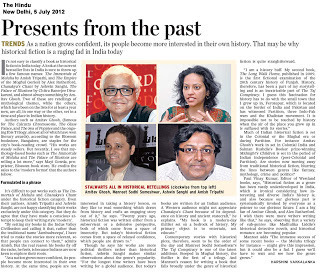 It’s not easy to classify a book as historical fictionin India today. A look at the current bestseller lists in India are sure to throw up a few famous names: The Immortals of Meluha by Amish Tripathi, and The Empire of the Moghul (series) by Alex Rutherford, Chanakya’s Chant by Ashwin Sanghi, The Palace of Illusions by Chitra Banerjee Divakaruni and almost always something by Amitav Ghosh. Two out of five of these names are retellings of mythological themes, while the others, which have been on the lists for at least a year now, are all, in one way or the other, set in a time and place in Indian history. Authors such as Amitav Ghosh, (famous for The Sea of Poppies and the ongoing Ibis Trilogy, The Calcutta Chromosome and The Glass Palace ), according to the Blossom bookstore, are staples for the city’s book-reading crowd. “His works are steady sellers. But recently, I see that mythology-based books such as The Immortals of Meluha and The Palace of Illusions are selling a lot more,” says Mayi Gowda, proprietor of a book store. He credits the sales to the ‘modern format’ that the authors follow. It’s difficult to put works such as The Immortals of Meluha and Chanakya’s Chant under the historical fiction category. Even their authors, Amish Tripathi and Ashwin Sanghi are not happy classifying their works, exclusively under the category. But they do agree that they have made a conscious attempt to keep their writing style ‘modern’. “By setting my books in the Indus Valley Civilization and calling it that rather than the tradition name ‘Jambudweepa’, I have tried to make them more relevant, so that people can connect to them,” admits Amish. But the real reason why his books fly off the racks, he feels, is because Indians are now keen to explore their roots. Though, he says, his works are more political thriller rather than historical fiction, Ashwin Sanghi also makes similar observations about the genre’s popularity. “For the longest time writers have been writing for a global audience. But today’s books are written for an Indian audience. A Western audience might not appreciate Chanakya’s Chant because of its dependence on history and ancient statecraft,” he explains. “My book is a modern-day thriller that draws on a bedrock of history. My primary object is to entertain, not educate.” Contemporary stories with historical plots, seem therefore, the order of the day and Manreet Sodhi Someshwar’s The Taj Conspiracy is one of its latest additions. Steeped in Mughal history, the thriller is the first of a trilogy. And Manreet’s reason for writing a book that falls broadly under the genre of historical fiction, is quite straightforward. “I am a history buff. My second book, The Long Walk Home , published in 2009 is the first fictional examination of the 20th century history of Punjab.” Much of Indian historical fiction is set in the Colonial or the Mughal era or during Partition. For instance Amitav Ghosh’s work in set in Colonial India or Salman Rushdie’s Booker prize winning Midnight’s Children is set in the period of Indian independence (post-Colonial and partition). Is there now a moving a way from traditional historical fiction, that is blurring the lines between similar genres like fantasy, mythology, crime and politics? Paul Vinay Kumar, Editor of Westland books has a refreshing take. “Historical fiction as a genre has been vastly underdeveloped in India, which is ironical considering how interesting and diverse India’s history is, and also because our glorious past is systematically invoked by everyone as a pointer to our glorious future. I am a big fan of Amitav Ghosh, and Alex Rutherford. I wish there were more writers writing like that,” he says, observing that a variety of sub genres like Madhulika Liddle’s historical detective novels, and historical romance are developing.http://www.thehindu.com/todays-paper/tp-features/tp-metroplus/article3592814.ece
It’s not easy to classify a book as historical fictionin India today. A look at the current bestseller lists in India are sure to throw up a few famous names: The Immortals of Meluha by Amish Tripathi, and The Empire of the Moghul (series) by Alex Rutherford, Chanakya’s Chant by Ashwin Sanghi, The Palace of Illusions by Chitra Banerjee Divakaruni and almost always something by Amitav Ghosh. Two out of five of these names are retellings of mythological themes, while the others, which have been on the lists for at least a year now, are all, in one way or the other, set in a time and place in Indian history. Authors such as Amitav Ghosh, (famous for The Sea of Poppies and the ongoing Ibis Trilogy, The Calcutta Chromosome and The Glass Palace ), according to the Blossom bookstore, are staples for the city’s book-reading crowd. “His works are steady sellers. But recently, I see that mythology-based books such as The Immortals of Meluha and The Palace of Illusions are selling a lot more,” says Mayi Gowda, proprietor of a book store. He credits the sales to the ‘modern format’ that the authors follow. It’s difficult to put works such as The Immortals of Meluha and Chanakya’s Chant under the historical fiction category. Even their authors, Amish Tripathi and Ashwin Sanghi are not happy classifying their works, exclusively under the category. But they do agree that they have made a conscious attempt to keep their writing style ‘modern’. “By setting my books in the Indus Valley Civilization and calling it that rather than the tradition name ‘Jambudweepa’, I have tried to make them more relevant, so that people can connect to them,” admits Amish. But the real reason why his books fly off the racks, he feels, is because Indians are now keen to explore their roots. Though, he says, his works are more political thriller rather than historical fiction, Ashwin Sanghi also makes similar observations about the genre’s popularity. “For the longest time writers have been writing for a global audience. But today’s books are written for an Indian audience. A Western audience might not appreciate Chanakya’s Chant because of its dependence on history and ancient statecraft,” he explains. “My book is a modern-day thriller that draws on a bedrock of history. My primary object is to entertain, not educate.” Contemporary stories with historical plots, seem therefore, the order of the day and Manreet Sodhi Someshwar’s The Taj Conspiracy is one of its latest additions. Steeped in Mughal history, the thriller is the first of a trilogy. And Manreet’s reason for writing a book that falls broadly under the genre of historical fiction, is quite straightforward. “I am a history buff. My second book, The Long Walk Home , published in 2009 is the first fictional examination of the 20th century history of Punjab.” Much of Indian historical fiction is set in the Colonial or the Mughal era or during Partition. For instance Amitav Ghosh’s work in set in Colonial India or Salman Rushdie’s Booker prize winning Midnight’s Children is set in the period of Indian independence (post-Colonial and partition). Is there now a moving a way from traditional historical fiction, that is blurring the lines between similar genres like fantasy, mythology, crime and politics? Paul Vinay Kumar, Editor of Westland books has a refreshing take. “Historical fiction as a genre has been vastly underdeveloped in India, which is ironical considering how interesting and diverse India’s history is, and also because our glorious past is systematically invoked by everyone as a pointer to our glorious future. I am a big fan of Amitav Ghosh, and Alex Rutherford. I wish there were more writers writing like that,” he says, observing that a variety of sub genres like Madhulika Liddle’s historical detective novels, and historical romance are developing.http://www.thehindu.com/todays-paper/tp-features/tp-metroplus/article3592814.ece
Published on June 13, 2012 02:51
June 10, 2012
Ashwin Sanghi in HT Cafe's READ
Published on June 10, 2012 04:54
June 7, 2012
Exotica Magazine: Bookworm: Chanakya's Chant
Published on June 07, 2012 05:03
March 21, 2012
The Telegraph, Kolkata, March 23: Bestselling Author Ashwin Sanghi On The Enduring Art of Politics
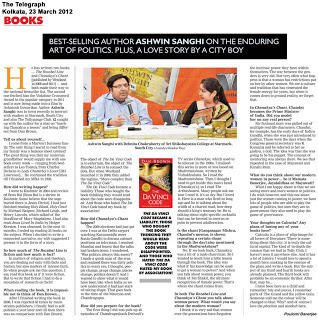
Best-selling author Ashwin Sanghi was in town to interact with readers.
Ashwin Sanghi with Debnita Chakraborty of Sri Shikshayatan College at Starmark, South City. (Anindya Shankar Ray)
He has written two books — The Rozabal Line and Chanakya's Chant [published by Westland in 2008 and 2011] — and both made their way to the national bestseller list. The second one fetched him the Vodafone Crossword Award in the popular category in 2011 and is now being made into a film by Ashutosh Gowariker. Author Ashwin Sanghi was in town recently to interact with readers at Starmark, South City, and also The Tollygunge Club. t2 caught up with the author for a chat on "teaching Chanakya a lesson" and being different from Dan Brown.
Tell us about yourself...
I come from a Marwari business family. The only thing I learnt to read from my family was a balance sheet (smiles)! The great thing was that my maternal grandfather would supply me with one book every week — ranging from bestsellers to Leo Tolstoy, from Charles Dickens to Lady Chatterley's Lover [DH Lawrence]… He continued the tradition till I finished my MBA in 1993.
How did writing happen?
I went to Kashmir in 2004 and revisited Roza Bal [Roza Bal is a shrine in Kashmir. Some believe that the sage buried there is Jesus Christ]. I had just finished reading Holy Blood, Holy Grail by Michael Baigent, Richard Leigh, and Henry Lincoln, which talked of the bloodline of Mary Magdalene. I had also read Jesus Lived In India by Holger Kersten. I was obsessed. In the next 10 months, I ended up reading 35 books on the subject. When I decided to write a connected narrative, my wife suggested I present it in the form of a story.
So how much of The Rozabal Line is fiction and how much is fact?
In matters of religion and theology, you are dealing not only with facts and history, but also matters of intense faith. So when people ask me this question, I say, read this book as if it were fiction. But to write that fiction I had to do a mountain of research on facts!
When reading the book, it is impossible not to think of Dan Brown…
After I finished writing the book in 2006, I was rejected 63 times by mainstream publishers. I finally had to self-publish a year later and till then there was no comparison with Dan Brown. The object of The Da Vinci Code is to entertain, the object of The Rozabal Line is to connect the dots. But when Westland launched it in 2008, they added the tagline, "More complex than The Da Vinci Code".
The Da Vinci Code became a liability. Those who bought the book thinking they would read about the code were disappointed. And those who hated The Da Vinci Code hated my book by association!
How did Chanakya's Chant happen?
The 2009 elections had just got over. I was at the Delhi airport watching Karunanidhi meet Sonia Gandhi to discuss cabinet positions on television. I reached Mumbai and learnt that the talks had broken down. I wondered, 'Was politics always this messy?' I made a quick scan of the eras and realised there was dirty politics in every era. I thought, people change, props change, places change, politics doesn't! And I wanted to show what it would have been like when India as we now understand it had just started taking shape. That goes back to the time of the Mauryas and Chandragupta.
How did you prepare for the book?
The first thing I did was pick up 48 episodes of Chandraprakash Dwivedi's TV series Chanakya, which used to be telecast in the 1990s. I realised this series is more or less based on Mudrarakshasa, written by Vishakhadatta. So I read the Mudrarakshasa. Then I thought I need to get inside this man's head [Chanakya's], so I read The Arthashastra. Many people ask me how I read it, it's so dry. But I loved it. Here is a man who lived so long ago and he is talking about the width of a chariot road, how deep should a king's treasury be. He is talking about eight specific cocktails that can be brewed in taverns or pubs to prevent adulteration.
Is the chant [Gangasagar Mishra, Chandni's mentor, is shown repeating a certain chant through the day] also mentioned in the Mudrarakshasa?
No. If we look back, Chanakya was a bit of a male chauvinist. So I wanted to teach him a little lesson through the book. The idea was what if his knowledge can be used to get a woman to power? And when you talk about woman power, you think of Ma Shakti, the ultimate recognition of female power. That's where the chant comes from.
In both The Rozabal Line and Chanakya's Chant you talk about woman power. What would you say about the modern woman?
I think it is very sad that women over the generations have forgotten the intrinsic power they have within themselves. The war between the genders is very old. But very often what happens is that a woman has restrictions put on her by other women. We are a culture and tradition that has venerated the female energy for years, but when it comes down to ground reality, we forget that.
In Chanakya's Chant, Chandni becomes the Prime Minister of India. Did you model her on any real person?
My fictional story was pulled out of multiple real-life characters. Chandni, for example, has the early days of Indira Gandhi, when she was just introduced to politics. Those were the days when the Congress general secretary was K Kamaraj and he referred to her as gudiya, a doll. The idea was that she was going to be his puppet. The concept of mentoring was always there. We see that repeated in the case of Mayawati and Kanshi Ram.
What do you think about our modern women in power… be it Mamata Banerjee, Jayalalithaa or Mayawati?
What I am happy about is that we are seeing more and more women in politics. I do wish however, and this not about just the women coming to power, we have lots of people who are able to play the game of politics, but once they are in government they also need to play the game of governance.
Your thoughts on Calcutta? Any plans of basing any of your books here?
Calcutta is a place of pilgrimage for all lovers of literature. There is something about this city; it is truly the cultural capital. The kind of in-depth discussion that we had in Tolly Club, I haven't seen it anywhere else. And it has a lot of history. I would love to spend a month here, soaking in the essence of the place and write a book. But the subject of my third and fourth books are already planned. The third book will probably be an economic thriller. After that, may be...
I have been here as a child and remember bits and pieces, I remember parts of The Grand and the yellow taxis. Someone told me the colour will be changed to blue. Why? And of course I love the phuchka and sandesh here.
Published on March 21, 2012 05:53

